15 Essential RV Accessories: Sewer, Water, Electric
These must-have RV accessories are what we use daily for our RV travels. Stop wasting money on unnecessary RV gear and read Todd’s recommendations. Then you can buy the items you will actually use.
When we first bought our trailer, I was excited to realize it was now ours. I couldn’t wait to start the adventure.
Reality sunk in as I slowly realized our new and perfect RV was actually very incomplete. If we hit the road right then and there, we wouldn’t make it very far.
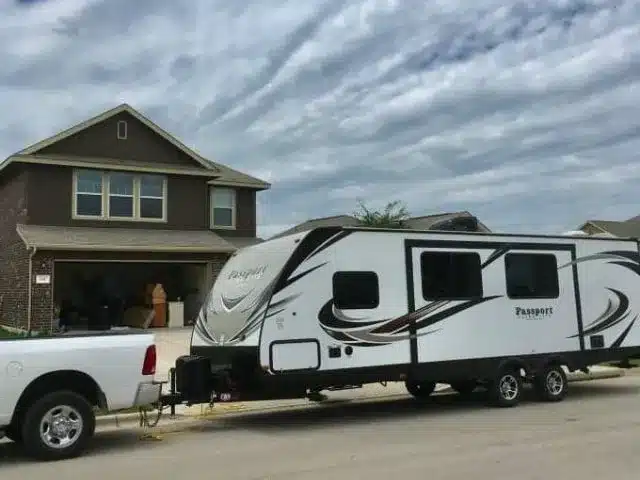
This shiny new travel trailer needed help. It needed partners. It needed supporting characters in order to become the “adventure capsule” we dreamed of.
Sigh. And so the next chapter of research and preparation began.
What You Really Need for Your RV
While nobody wants to buy stuff they will never use, we are all willing to buy what we actually need and will use. In fact, we’re not only willing, but also quite eager to find and buy what we need.
This is particularly true when you’re lugging all of that stuff around with you in your mobile house for months! Everybody wants the essential gear. Nobody wants to pack extra junk.
I watched dozens of videos about how to prepare for our upcoming months-long RV road trip.
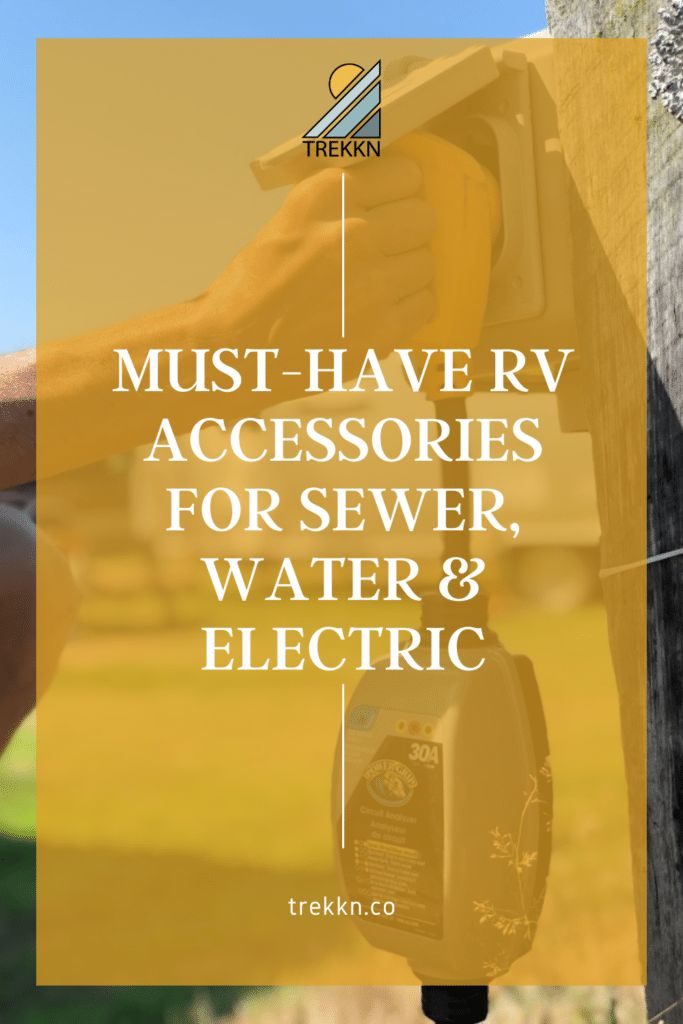
I had a hard time finding a one-stop resource that explained all of the items we would need for a full-time RV lifestyle.
Instead, I found one video about holding tank accessories and a separate video about cellular connections. I searched again and found a third source for tires. You get the idea.
So I wrote key guides to help you avoid that time consuming process. This overview covers the must-have RV sewer, water, and electrical accessories. These are the products we absolutely needed and used.
We have also published a guide for RV Internet Connections and one for Tires & Overall Safety.
This guide provides an overview of essential water, sewer, and electrical supplies you need for full-time RV travel.
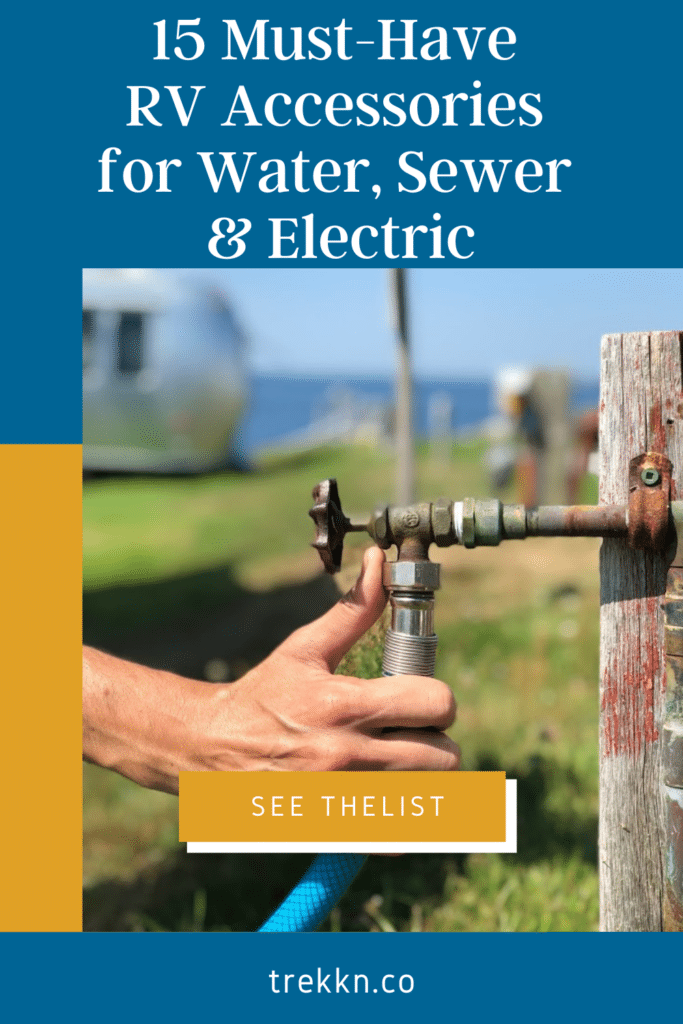
TREKKN is ready-supported. We may earn a small commission for qualifying purchases, at no additional cost to you. Please read our disclosure for more information.
RV Accessories for Sewer, Water and Electric
RV Sewer Connections
Let’s get the dirtiest stuff out of the way quickly, sound good? Nobody likes dealing with this stuff, but that’s not going to keep your tanks from filling up!
20′ RV Sewer Hose
Here’s the deal: you should have a quality sewer hose that is, at a minimum, 20 feet in length. That allows you more confidence that you will be able to reach the sewer connection at your campsites.
After visiting dozens of RV parks, the 20′ hose has not let us down. It has been close a couple times.
Based on our personal experience, the Camco Rhino Sewer hoses are the gold standard in the industry. They’re considered the best RV sewer hose on the market.
This RV / Camper sewer hose kit is ready to use straight out of the box to take care of your grey and black water tanks. Transparent elbow design helps you identify when the tanks are clear.
- Two 10' camper / RV Sewer hoses
- Pre-attached bayonet & lug fittings
- Constructed with durable polyolefin and steel wire
- 4-in-1 adapter and 4 storage caps
We have the 20′ RhinoFLEX setup pictured above. However, I might go with the 20′ RhinoEXTREME option if we were to start a fresh RVing adventure. I may even splurge and replace our current RhinoFLEX soon.
TPE Technology protects against pinholes. This hose is resistant to dents, rush, and crushing. As with the RhinoFLEX, the RhinoEXTREME includes two 10' sewer hoses with a translucent elbow.
Both hoses receive very high reviews. But, the EXTREME model does seem to have more 1-star reviews due to leaking issues.
I have had minimal issues with leaking after nearly a year with the RhinoFLEX. You can also look at the full list of Rhino RV Sewer hoses for more information. Select the model that’s right for you.
Remember, get a sewer hose that is at least 20 feet long to avoid major disruptions to your RVing enjoyment.
Transparent RV Sewer Tank Rinser
RHINO also makes a handy accessory called the Rhino Blaster RV Tank Rinser.
I wouldn’t necessarily label this as cheap as I look at a piece of plastic. But, it’s more than that. Being able to rinse the main sewer drain pipe AND actually see what’s coming out of the tanks is important. That allows you to ensure a thorough flush of the system.
Tank rinser attaches to RV sewer outlet to rinse out all of the residue. Camco's Rhino Blaster is designed with a vacuum breaker to prevent back flow into the water hose.
- 360-degree swivel fittings
- Vacuum breaker
- On/off water valve
- Durable and lightweight at 12.8 ounces
This is not an area where you want to pinch pennies. Trust me. A good, thorough rinse helps reduce odors and avoid nasty clogs in the system.
Sewer Hose Rinse Cap
This comes in handy after you have completed the tank draining process and detached your hose from the rig. The Camco Hose Rinse Attachment snaps on the end of the sewer hose. Then you use it to blast water through for a good rinse into the sewer before detaching that end.
Lock this onto sewer bayonet fitting and connects to standard garden hose to thoroughly rinse out your sewer hose before storing.
- Shut-off valve controls water flow
- Doubles as hose cap and can be left on during storage
- Fits Camco RhinoFLEX and standard sewer fittings
- Less than 5 ounces
Honestly, I have been a bit lazy and have not used this great accessory as much as I should. And, of course, I regret it. For such a lightweight little tool, it’s amazing. I can pretty much guarantee you will regret it if you don’t include this in your toolkit.
RV Sewer Hose Support
Don’t scroll past this accessory too quickly. It may seem superfluous, but some RV parks actually require that sewer hoses are kept off the ground. That has been true with several of the parks where we stayed. They require the use of a sewer hose support.
Moreover, it’s quite useful.
The Sidewinder RV Sewer Hose Support has been perfect for us for more than a year. I honestly have no complaints at all and can highly recommend it based on personal experience.
Protect and support your RV sewer hose and comply with park regulations. Flexible designed with downward slope allows you to curve around obstacles. Be sure to buy length to match your sewer hose (this one is 20').
- Flexible and telescoping design
- Folds for easy storage in compact space
- Includes carrying handle
This particular sewer hose support is flexible and also features a telescoping design. It easily folds back up. Then you can clip it closed with the carry handle before storing it in a compact space.
The RV sewer hose support comes in different lengths, just like the hoses. So be sure you get the correct length based on the sewer hose you have. If you use a 20 foot RV sewer hose, you should get a 20 foot sewer hose support to match.
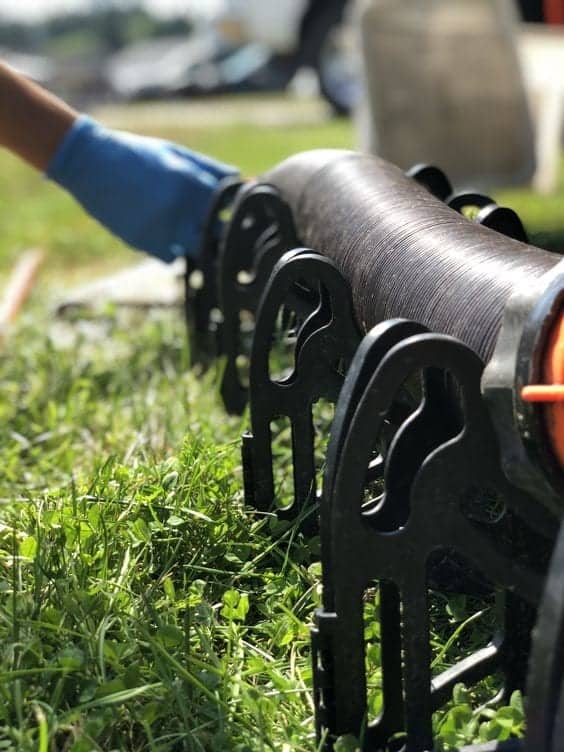
On top of the occasional RV park requirement issue mentioned above, this sewer hose support is designed with a slope. That helps to ensure the hose is angled down and things keep flowing along.
It saves time, energy and possibly a mess as you would inevitably fight to drain the sewer hose with it.
The more you have to fight with the hose to get it fully drained, the more wear and tear the hose and fittings will experience. And we all know what that could mean…
Disposable Gloves for Sewer Tank Cleaning
Yes, ladies and gentlemen, you should absolutely use disposable gloves for sewer tasks, in my humble opinion.
I use them each and every time I handle the sewer equipment. I also immediately sanitize after I’ve completed the chore. It’s the smart thing to do and worth a few extra bucks.
Obviously, there are plenty of glove options. From polyethylene like you see above, to vinyl gloves, latex gloves or nitrile, you can easily find the right fit.
What you choose ultimately depends on your comfort level in handling this dark deed.
RV Holding Tank Treatment
The truth is, I have been using whatever I can track down at Walmart for most of our travels.
But, if you want the best, then use Happy Campers. the best RV holding tank treatment product that came highly recommended to me from RV professionals is Happy Campers RV Holding Tank Treatment.
Water-activated odor neutralizer. One scoop treats a 40 gallon tank to liquify waste solids and tissue, and remove odors.
Happy Camper Tank Treatment is an organic product that is apparently superior in its ability to break down waste. It’s more spendy than what I normally use, but it’s worth it from what I hear.
Alright, that’s enough with the poo water. Let’s move on to the drinking water side of things and explore our top recommendations.
RV Water Connections
Drinking Water Hoses
Now, you wouldn’t think this decision would be that crucial. But I have something to tell you from personal experience. Making the right decision on water hoses will save you money and major hassles in the long run.
I went through two hoses in the first two months of our travels because they leaked at the connection fittings. Every time it was a struggle and resulted in a lot of wasted water. Not cool.
Finally, I had to replace the hose again while at an RV park near Glacier National Park in Montana. The option they had in stock was the Camco TastePure. The heavy-duty nickel-plated brass machined fittings made all the difference.
This premium drinking water hose from Camco is designed with extra strength fittings and will not kink.
- No-kink
- Lead-free, BPA-free, Phthalate-free
- 25 feet in length
I would also like to mention my poor decision at the outset led to me paying a much higher price. The price I paid at the RV park was nearly three times higher than the current price offered at Amazon. Don’t forget, that was after the first two hoses I purchased leaked. Sigh.
Choose wisely now….
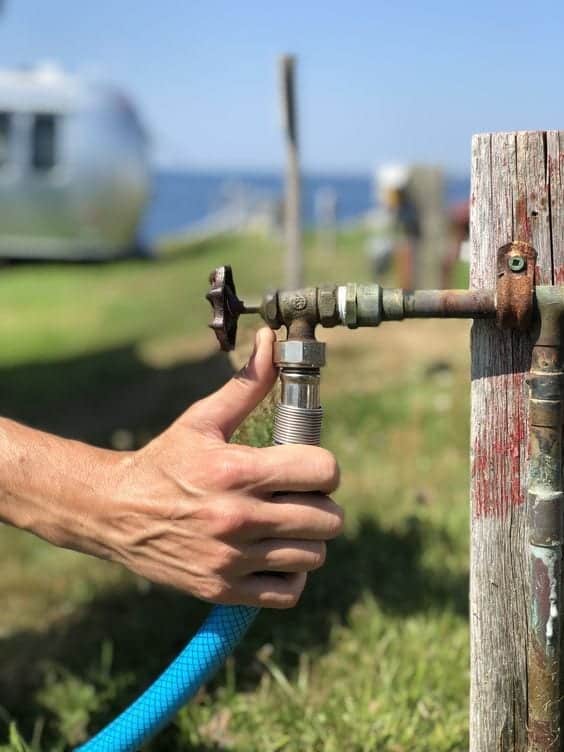
I have one last point to make that may be helpful as you decide which drinking water hose to buy. I recommend having two 25-ft hoses. The reason is two-fold. First, the water connections are sometimes located in a strange places that cannot be reached with a single 25 foot hose. Also, I don’t want to wrestle with a 50 foot hose every time I connect.
Holding Tank Rinsing Hose
I know, I know. You’re thinking that three hoses for one RV is complete overkill. I get it. And I would have agreed a year ago.
But here’s the deal: You can’t use a drinking water hose to attach to your black tank (sewer) flush valve! There is always the possibility of backflow from the black tank, even with safety measures in place. That could lead to a medical disaster.
The drinking water hose recommended above is about the same price as any standard 25-ft garden hose on Amazon. (Unless you buy it in an emergency from an RV park! As we learned.)
Purchase Different Types of Hoses
You want to have different types of hoses. Pick something very different from your drinking water hose to use for flushing the tanks to prevent mixing up the hoses. Get a reasonably priced, durable 1/2 inch, lighter weight garden hose for rinsing the holding tank.
Water Connector Elbow
Here’s a nice little item that’s cheap to break up the expenses a bit. It’s solid brass and will absolutely help ensure you are not placing unnecessary pressure on that RV water connection.
- Easy grip swivel connector
- Fits 3/4" to 11.5 NH hose connections
- Eliminate hose kinking
Water Pressure Regulator
Now, I made a mistake with this relatively small purchase.
Originally, I bought this water pressure reducer, which is called a regulator. It’s not what I needed. Another RVer helped educate me so I hope this is also helpful for you.
The difference between the reducer device I initially bought and the water pressure regulator I actually needed is that the latter has a gauge. The gauge allows you to see the actual amount of water pressure.
Help protect your hose and plumbing system from high pressure city water. This regulator from Camco includes an easy-to-read gauge to monitor the water pressure. Attaches with 3/4" garden hose threads.
Water Filters
This one is pretty straightforward. These simple and inexpensive inline filters are attached to the brass elbow and the hose to reduce sediment from entering your RV’s water system. It also improves the taste of the water.
Each one lasts 2-3 months, so it is a pretty small price to pay for a little peace of mind.
Heated Drinking Water Hose
This is an expensive option you should only consider if you are going to be RVing in temperatures below freezing. And have I got a story behind this one!
- Heating cable protects against freezes to -40° F
- Includes adapter allowing connection at either end of hose
- Approximately 8 pounds
I spent over $100 on a heated hose. We had decided to head to Utah and Colorado in November 2017 as temperatures were dropping. And I had grown tired of having to disconnect the water hose every night and drain it. Then head out in the morning cold to reconnect it before anyone could even brush their teeth.
Ummm…Moab, Utah Gets Cold!
We stopped in Moab, Utah. It was only a few days after spending the money on a heated water hose. It was freezing, and I made a critical error.
I plugged the hose’s cord into the outlet on the pedestal next to the water connection. But, I did not double check to be sure the outlet was actually ON. Big mistake.
The next morning, the hose was frozen solid (temps hit about 10 degrees Fahrenheit).
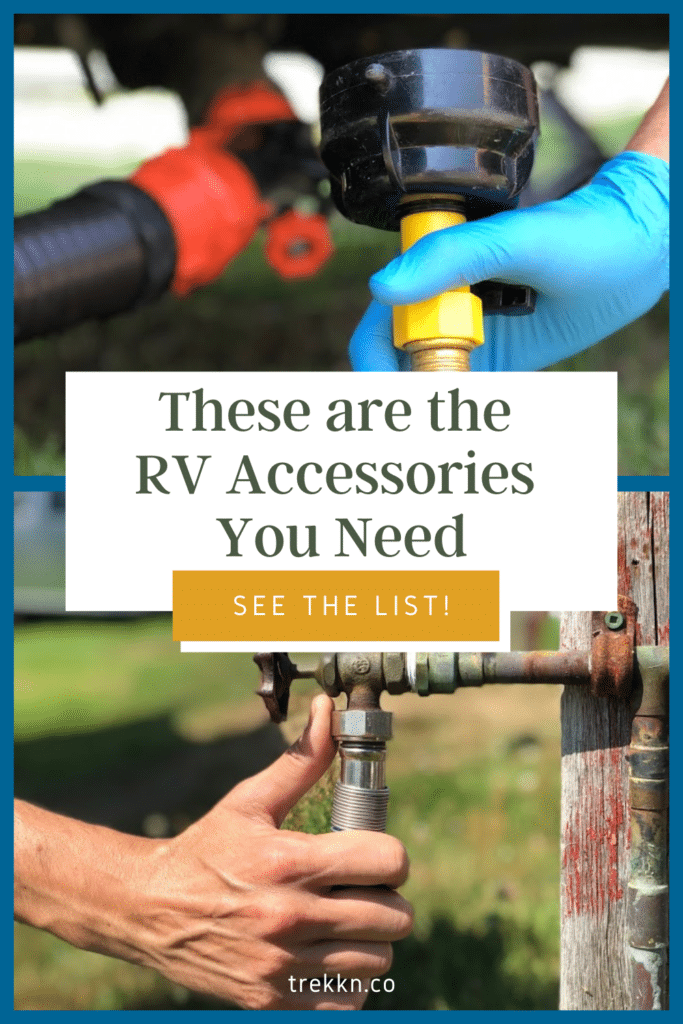
The heating element had also frozen and cracked. No more heated hose. (I was able to just remove the heating element and still use the hose as a backup drinking water hose, so not all was lost.)
One last note: After I destroyed that expensive heated hose, I was shown a way to create my own heated hose, with very little hassle, using parts that cost 1/3 to 1/2 as much as your average heated hose off the shelf.
You can take a look at this quick tutorial on YouTube that presents essentially the same steps I took.
I only used a 10-ft hose which made my process quicker and a bit less expensive. That DIY project hose has served me well for months and only cost about $45.
RV Electrical Accessories
RV Surge Protector and Circuit Analyzer
A 30 amp RV surge protector and circuit analyzer was one of the first items that I purchased when I brought my travel trailer home.
Why? I had seen too many horror stories about shore power electrical issues that fried an RV’s electrical system. If something was wrong with the power grid I was about to plug my huge investment into, I wanted to know!
30-Amp Male and 30-Amp Female voltage protector helps protect your RV or camper from high and low voltage levels and power surges.
- Auto connect and disconnect
- Weatherproof
This might be one of the pricier RV accessories you need to buy, but it is absolutely worth it when you factor in the investment you are trying to protect.
I highly recommend the Camco Power Grip based on the positive experience we had with the product.
Note: This particular item is an RV Surge Protector 30 amp for a system like mine. If you have a 50 amp system (usually indicated by two AC units on the rig), be sure to search for a 50 amp surge protector option with strong reviews.
50-Amp to 30-Amp Adapter
I have run into some situations where the only shore power available at an RV park was 50 amp.
If I just had the surge protector above, I would not be able to plug it into that power supply. It is a completely different type of plug on the two power supplies.
But take a look at this inexpensive 50 amp to 30 amp adapter. It gives me the option to plug my 30 amp travel trailer into a 50 amp supply without an issue.
Converts electrical connection at campground to fit your RV 30-Amp system. Designed with 90-degree heads to reduce pressure on the adapter. Weighs about 1.5 pounds.
In situations like this, I put the circuit analyzer and the adapter together.
I simply plug the 50 amp adapter into the power supply, then plug the circuit analyzer into the adapter, and finally my power cord from the travel trailer into the bottom of the circuit analyzer. Voila. Adapted, protected, done. Zero hassle, zero headache, zero risk.
30-Amp to 15-Amp Dogbone Adapter
I know! You’re thinking, “Enough with the dogbones already! Jeez!” That’s what I was thinking, too as I collected my “toys”.
But here’s the deal: This final RV electrical adapter is a 30-Amp to 15-Amp adapter that allows you to connect to a standard household 15-Amp power supply in order to run the basics on your RV.
For us, this 30-Amp to 15-Amp adapter came in handy during our first few days in the RV while we were parked at my wife’s parents’ home in Texas.
Converts electrical connection at campground or home base to fit your RV 30-Amp system. The 90-degree head design reduces pressure on the adapter. Weighs about 1 pound.
As I said, a 15-Amp power supply is only going to run the basics in your rig…no A/C or heater, and probably no microwave. You might get away with using the toaster. It basically allowed us to keep our electronic devices charged using the electrical outlets in the RV.
RV Done With This List Yet?
And….there you have it! Lots of details and lots to think about while you make informed purchase decisions. It’s ok to simply take it one step at a time.
Believe me, my head was absolutely spinning as I tried to compile the list of RV accessories we needed most before hitting the road. I thought I would never get to the bottom of that list. But, it all came together to support us during some amazing adventures.
Remember, this is just a portion of the RV tools, equipment and accessories I would recommend. You should also click here to check out my top 5 RV camping accessories to maintain your sanity on the road.
In addition, I’ve covered the travel and safety side of the equation (tires, tire pressure monitor, torque wrench, etc.) as well as the on-the-road data connectivity issues (cellular devices, hotspots, satellite, etc.).
But these 15 RV accessories will give you a great start on your mission to hit the road, see the country (or countries), and live a life well traveled!
Safe travels, friends!
PIN THIS TO SAVE FOR LATER
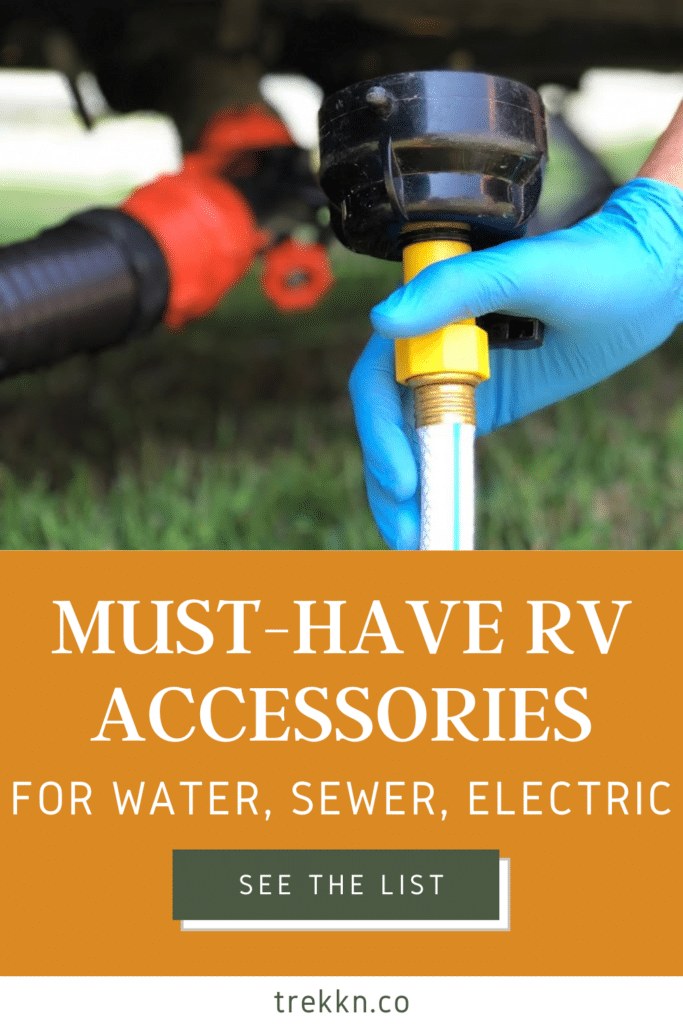

Todd loves a competitive game of table tennis, a breathtaking hike, and exploring new places. He lived and traveled in an RV with his family as they traveled throughout much of the US and parts of Canada. Todd has extensive knowledge about RV travel, safety, and accessories and has shared many of his stories here on TREKKN. When he’s not busy launching and building small businesses, you may find him staring at pictures of Glacier National Park (probably his favorite spot on earth).


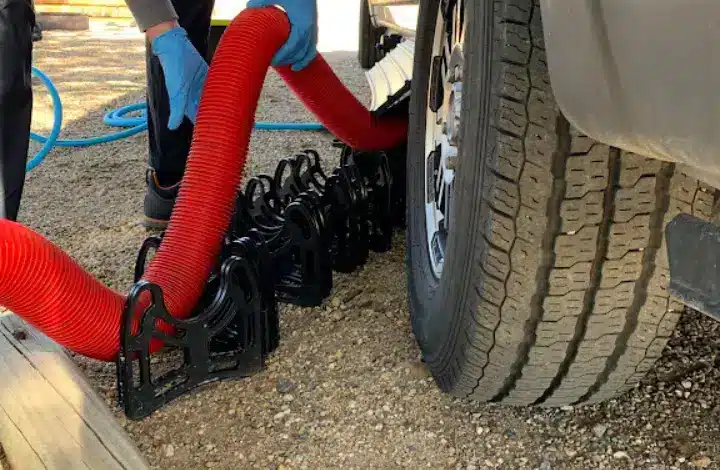














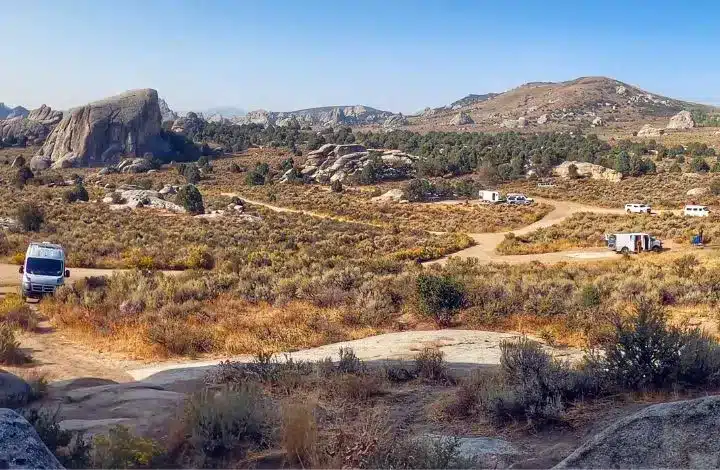
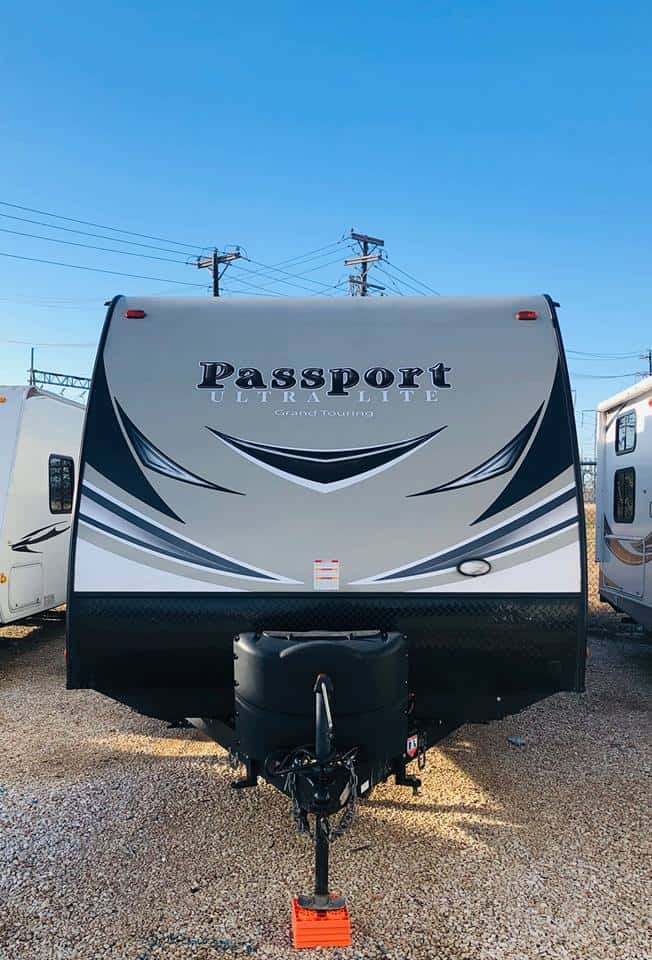
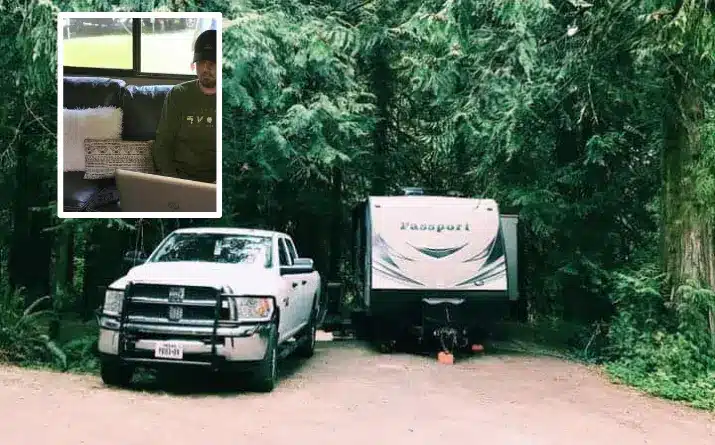
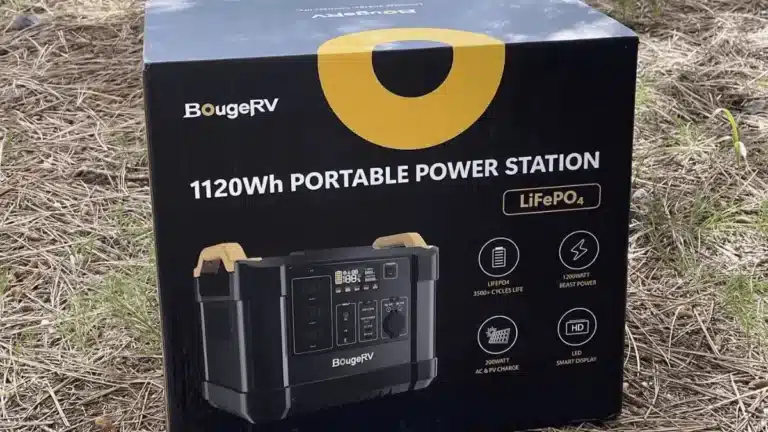
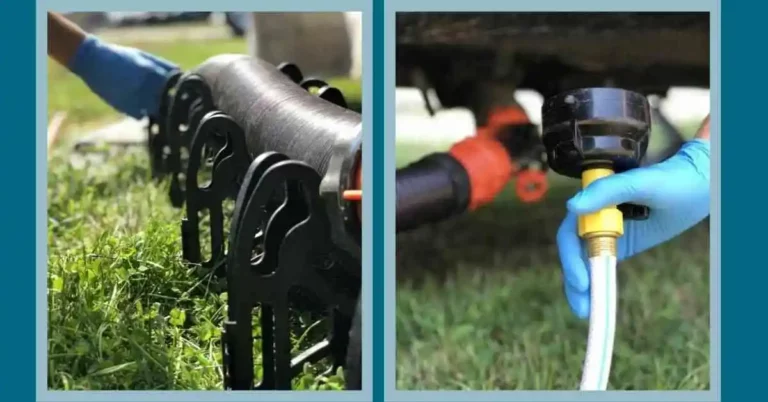
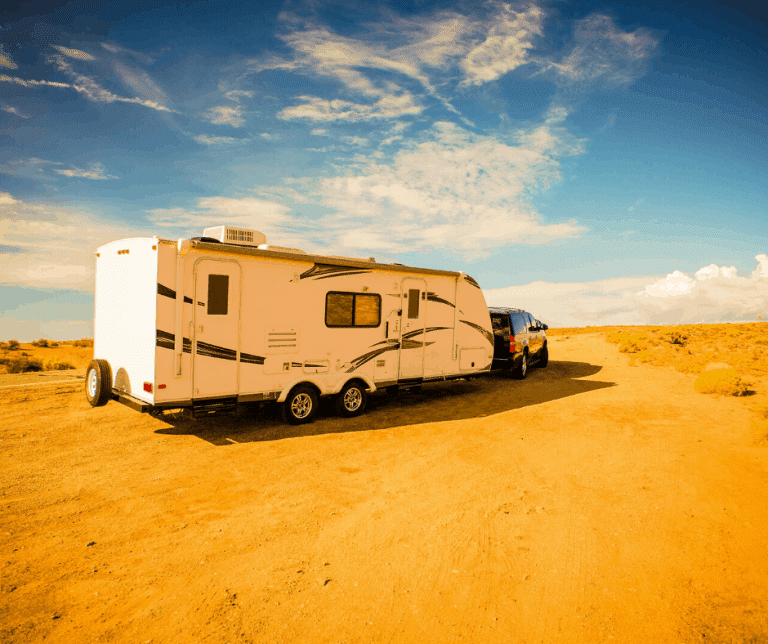
Have you considered helping travel trailer owners with weight distribution hitch storage? HITCHPORT Storage Mounts store the hitch and spring bars on the trailer tongue at a convenient height for quick and easy hitching while freeing up valuable compartment space and leaving a greasy hitch outside. Secure it with a deadbolt pin or python cable lock. See DEMO and testimonials hitchport.com
Hey Gary. Thanks for this! I’ll have Todd check this out. Definitely sounds like something he’d be interested in. – Julie
What have you found to be the most reliable way to get internet for people working while traveling??
Hi Lauren,
For us, we have used our Verizon unlimited plan. We use our data to stream movies, videos, etc and use our hotspot for connecting to the internet for work. If our hotspot runs out on our phones, we have one Verizon Jetpack to use as a backup. (This one here: https://amzn.to/2JJtrkA)
We also purchased a WeBoost (this one here: https://amzn.to/2O9j39A) to boost our cell signal when it’s weak and it has worked well. There are times when we have zero cell signal and nothing works. So, we either use the RV park’s wifi (if they have it) or go to a cafe to work. We’ve also sat in many parking lots to work. 🙂
This article’s insightful observation of the incompleteness of a new RV for the job it is intended to do is a rueful truth that all prospective owners would do well to heed. In fact, the “accessories” the article refers to SHOULD NOT be considered accessories at all. They should be considered integral necessities routinely incorporated into every new trailer by the manufacturer which produces a better end product and saves the new owner huge amounts of time, frustration and money.
The RV industry is notorious for delivering products with many known defects and heaping the repairs on their dealers. Solutions to this industry-wide travesty are better standards and an informed public who demands a better product.
I cannot disagree with you there, Stephen. Going into the “RV world” without an understanding of its shortcomings and potential pitfalls has absolutely left many owners in difficult situations. In my situation, I researched enough to become aware of the MAJOR issue with tires on travel trailers being subpar, even dangerous, and not sufficient for the job they needed to do. So I spent the extra money up front on new, quality tires for our travel trailer as well as a TPMS system to avoid potential disaster. Probably the best decisions I have made related to this journey.
And you are right…these items could very easily be labeled as necessities, not accessories. I appreciate your input very much! All the best. – Todd
Hi……I have now lived 1 year in my 5th wheel. I don’t travel, but have a lovely spot.
All your tips are great.
I have one that will get rid of your first tip. BUY A INCINOLET toilet.
I HATE POOP! This incinerator toilet cost about 2 grand and then I had it put in
professionally by my RV dealer. Another 1 grand. WELL WORTH IT. You need liners at about
$35 per 400 liners.( max..1 person 8~10 per day )
I was paying $100 each time the pumper came out. It has been amazing. About every 2 weeks I empty what looks like a big frying pan of ashes. That’s it. No smell .
The only drawback is that you need power.
Thank you for all of your great tips. I so look forward to more ideas.
Hi Kathy. I didn’t even know that existed! We hate poop too! LOL Thanks for stopping by. 🙂
Thank you so much Todd for this!!! Just got our rig…and our heads were swimming with bits of info here and there. We so very much appreciate your list and advise and the links to Amazon! 😃. We will be following you for more info on tips and safety. Safe travels.
You are very welcome! It’s always awesome to hear that I’ve been able to toss a “life preserver” to another swimming head. I remember it well!
Thanks for your encouragement, and congrats on the new rig! Now keep those heads above water. 🙂
Todd
Thank you for these incredible tips! Hubby & I are researching rigs and happily found this article. Your thoroughness is truly appreciated, I can tell by the comments that the Amazon links you shared (which we will definitely be back to click through and purchase), you have saved us time, energy and potential problems.
Hi Buffy, that is really great to hear! It’s always nice to know that our work is helping folks out, and this is definitely what we would have loved to have during our “buying spree”. 🙂
Best wishes in your RV research and buying efforts! Are you planning to full-time or just do occasional trips in the new rig?
Take care!
Todd
Todd, great list. I have a collection of must haves that proved to be more “not exactly” than essential. A small, but not so insignificant, item I would add to the ABSOLUTELY essential list is tire chocks. Seen a couple of videos of rigs rolling away when detached from their tow vehicle, or when the owner failed to apply parking brake and put the tow vehicle in PARK. The last statement was verified by personal experience, spelled O-O-P-S! Fortunately, I managed to get into the truck and apply the breaks before the trailer impacted anything. So, definitely, tire chocks.
-dp
Excellent point, Don! I had a couple of scary moments myself when we were full-timing with the travel trailer. It’s too easy to forget one little detail, like chocks, and end up in a world of hurt.
Thanks for your input and happy travels, Don.